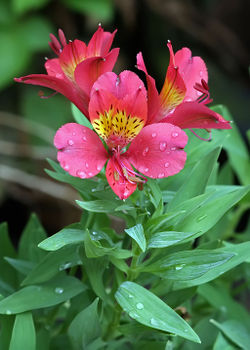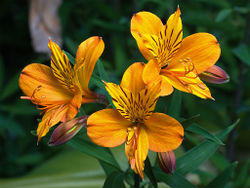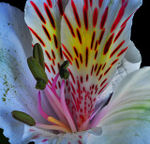Lily of the Incas
| Lily of the Incas |
|---|

|
| Scientific Classification |
|
| Species |
|
| Three flowers of the Peruvian Lily |
Lily of the Incas are species of flowering plants within the taxonomic genus Alstroemeria. They are also commonly known as Peruvian lily - the names reflecting that they are native to South America. They can reach heights from 12 to 36 cm. Their life cycle is a simple Hardy perennial, Bulb, and Hardy annual (Alstroemeria graminea).[2] it requires a growing region from 7 to 10 (a geographically defined area in which a specific category of plant life is capable of growing). Alstroemeria can be blue, red, orange, green, purple, pink, or white. It will flower in the late spring and summer.
Body Design
All 'Lily of the Incas' have about the same color and feel for the petals and sepals. Each flower has three sepals and three petals. The roots of sometimes have a spiral to their roots. The veins of the do not branch across leaves but up.Cite error: Invalid <ref> tag; invalid names, e.g. too many If you look closely you can see that the leaves are upside down.[3] This is so the flowers can get sunlight.[4] The colors are very vibrant which attracts bees, butterflies, and birds. You can sometimes see a spiral growth pattern on the stem.[5]
Life Cycle
Lily of the Incas should be grown in full sun and in rich, light, slightly acidic soil.[6]The life cycle of Lily of the Incas begins with them starting as a Hardy perennial. This means they can survive for a long time and aren't killed by winter.[7] They are expected to live longer then two years. Then they ascend into a bulb. The bulb is a storage area which contains organs present in some flowers. Such as food storage.
Ecology
Some Lily of the Incas are used in cut flower bouquets. Also some have migrated and have become weeds in places like Australia.[8] The roots of the Lily of the Incas grow like wildfire when left unchecked. Digging them up will only do so much. [9] They are native to South America, some have become naturalized in the USA, Mexico, Australia and more.
Video
Lily of the Incasproduce clusters of Lily-like flowers in abundance on long strong stems in Summer and many varieties have lovely soft shades of colors with interesting marking, meaning these plants make excellent cut flowers and are great for pot displays. These are perfect for achieving an exotic late summer splash of beautiful colors in a compact size and style.
References
- ↑ unknown, unknown. Plant Profile Publisher or Publishing Site. Web. not known, 5/15/15.
- ↑ How to Grow Alstroemeria Plants Guide to Growing Peruvian lily GardenerHQ. Web. 5/26/15.
- ↑ [1] theflowerexpert.com/. Web. 5/18/15
- ↑ Unknown. Alstroemeria http://beneva.com/. Web. 5/18/15.
- ↑ Edward, Even. Peruvian Localwiki. Web. 5/27/15.
- ↑ How to Grow and Care for Peruvian Lily Plants The Garden Helper. Web. 5/26/15.
- ↑ Unknown. Hardy perennial macmillandictionary. Web. 5/22/15.
- ↑ How to Grow and Care for Peruvian Lily Plants The Gardner Helper. Web. 5/26/15.
- ↑ Garden Q&A: You'll come to regret planting Peruvian lilies Jacksonville. Web. 5/26/15.



